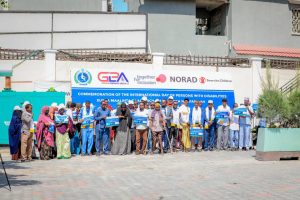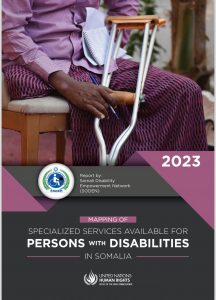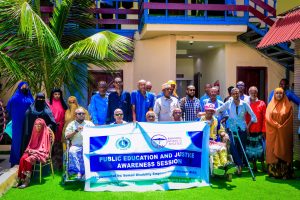Emerging from two decades of civil war and lawlessness, Somalia’s people are struggling with poverty and continuing violence. And, as in many societies, people with disabilities are the hardest hit.
“People with disabilities, particularly women and children, are the most vulnerable and discriminated against in Somalia,” says Mohamed Ali Farah, director and co-founder of Somali Disability Empowerment Network (SODEN).
“For example, less than 1% of disabled children are enrolled in school here.”
Mohamed speaks from direct experience. The thirty-one-year-old contracted polio at the age of three. His family, like many with disabled children in Somalia, didn’t send him to school. Through his own initiative, he started attending school at the age of 14 but, without a wheelchair, had to crawl through the streets to get there. The temperature in Somalia often reaches 95 degrees F and the ground was scorching.
Discrimination against people with disabilities is a global issue. The World report on disability, co-produced by the World Health Organization (WHO) and the World Bank, estimates that there are more than a billion people with disabilities worldwide. They are generally the least educated and poorest members of society. UN figures indicate that children with disabilities are often the last to receive food or medical care and the first to die. Girls with disabilities are three times more likely to be sexually abused than girls without disabilities.
“More than two decades of conflict, inadequate health services and discrimination have left people with disabilities in Somalia at risk of forced marriage, violence, rape and repeated forced evictions,” according to a briefing published by Amnesty International on March 12, 2015. (Listen to an interview on BBC Somali with Mohamed’s response to the report — in the Somali language.)
Two decades of civil war, as well as continuing conflict, has left disabled Somalians struggling with access to education, health services and employment.
The difficult situation for disabled people in Somalia and Mohamed’s own struggle to get an education inspired him to start SODEN in 2011. His disability rights organization, based in Mogadishu, focuses on education for disabled children, as well as other issues.
“Last year, I was able to convince five families to send their children to school.”

Media and Disability
Mohamed wants to use media to change negative social attitudes about disability and to reach more families with his message about education. But getting access to media is difficult.
“In Somalia, you can’t use the mass media unless you bribe them and most disability organizations don’t have enough money to bribe the media.”
Outside of disability issues, media in Somalia has its problems. The country is ranked 172 out 180 countries on the 2015 World Press Freedom Index produced by Reporters without Borders. According to InternetLiveStats, only 1.5% of the population or approximately 163,185 Somalians are online. (See Internews’ Somalia Media and Telecoms Landscape Guide)
For people with disabilities, getting the information they need and getting their voices heard is compounded by problems of invisibility, representation and access.
Accurate, comprehensive coverage of disability issues can help alleviate stigma and discrimination and increase understanding of the capabilities of disabled people, which can lead to increased employment and educational opportunities and the ability of disabled people to participate in and contribute to society. Increased awareness can also help decrease abuse — disabled women and children and people in institutions are particularly vulnerable.
Disabled people need access to accurate information (on health, education and employment) in accessible formats to become empowered, participate in society, make decisions about their lives and fight for their rights.
Delivering the information people need entails a three-pronged approach:
- Recruiting and training disabled journalists and media professionals, giving them the tools and technical assistance to make media production accessible.
- Training all journalists how to cover disability issues in an accurate, non-stereotypical and non-stigmatizing way.
- Making mass media accessible to people with all types of disabilities.
Working with Internews
In Somalia, Internews is conducting workshops on media literacy with members of civil society organizations, one of which Mohamed attended.
Before the workshop, Mohamed did not trust media professionals, nor did he see them as an integral part of his communication work. “I was suspicious towards journalists and felt they often twisted people’s words, covered stories only when bribed and were not interested in civil society issues.”
Internews Project Director, Fatuma Abdulahi, agrees that bribery is still one of the most problematic issues in Somali media. “Journalists have lost credibility in the eyes of civil society organizations, so connecting them constitutes a good first step to win back trust.”
Mohamed is happy that he has been able to obtain skills that can help him break down traditional barriers between journalists and the disability community. He is hopeful that he can help media professionals begin to understand why it is important to cover disability issues more comprehensively and accurately.
“I feel more confident about approaching the media now. I came to realize that journalists are not as I imagined.”
Mohamed was immediately able to put his new skills into practice on International Day of Persons with Disabilities, December 3, when he held a well-attended press conference.
Source: Internews





